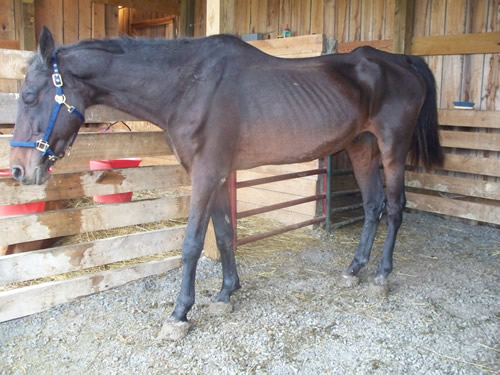
Neglected horse rescued by the Kentucky Horse Council
Unwanted horses
By Larry Hyslop

Neglected horse rescued by the Kentucky Horse Council
The United States has a large problem concerning unwanted horses. These are domestic horses that the owner can no longer afford, horses that are sick, lame, or untrained/dangerous. Several web sites address the problem, such as the American Veterinary Medical Association and the Unwanted Horse Coalition, a broad alliance formed under the American Horse Council. It is a large enough problem I will talk about the national picture this week and devote next week’s column to our local conditions.
This problem ballooned in September, 2007, when the country’s last horse processing plant closed its doors. Animal rights groups got laws passed forbidding the slaughter of horses for human consumption. Before the last three horse slaughter houses were forced to close, about 100,000 horses were processed each year so this is probably a fair guess of the number of unwanted horses today. After the closures, the number of horses being shipped to Canada and Mexico for slaughter jumped, raising concerns about humane treatment. A bill in the U.S. House of Representatives, if passed, will outlaw such transport. (This article covers only domestic horses and does not count the 30,000+ unwanted captive wild horses that spend their lives in BLM long-term care facilities.)
Before 1979, horses were shipped by boat, live, to Europe to be processing as meat. Slaughter houses in the U.S. opened to process that meat here and alleviate high mortality rates in transit. These slaughterhouses had inspectors and veterinarians on hand to ensure humane treatment.
Horse meat contains more protein and less fat than beef. People in the U.S. have historically eaten horse meat but animal rights groups say the world should not be eating it. Zoos routinely fed horse meat to predators but many have stopped due to outside pressure.
All this has left a depressed or crushed domestic horse market. Before the closures, any horse was worth $300-500 since it could be sold to a slaughterhouse. With no way to remove unwanted horses from the market, poor quality horses are worth less than $100 if anything at all.
The American Veterinary Medical Association estimates it costs $1825 yearly to care for a horse. This does not include farrier, veterinarian costs or the recent increases in hay costs. Many horse owners are trapped, not able to afford the horse but not able to sell it.
The only recourse for old, sick or lame horses is euthanization, which often costs over $100 and is merely the easy part. Getting rid of the carcass may require hiring a backhoe for $300 and then only if the owner can legally bury the carcass on their property. Many landfills no longer take carcasses and rendering plants are charging substantial fees to remove carcasses. Horse rescue organizations are already full. They are feeling a double pinch, too many horses and not enough money in this economy.
Since the slaughter house closures, the numbers of neglected and abused horses has risen sharply. In many cases, distraught owners simply abandon their horses. Ranchers and farmers find extra horses in their fields. Abandoned horses are killed by cars driving rural roads. At the end of the day, horse auction barns find horses tied up and abandoned. Native American reservations are especially hard hit since horse owners assume natives will gladly take in one more horse.
Perhaps the worst culprits drive their horse trailer onto public land and release their horse before driving away, content in knowing their horse is now living wild. They do not see their horse die of starvation or thirst, not knowing where to find water and not used to finding its own food. Wild horse bands typically do not take in unknown horses.
Horse slaughter is definitely not the answer, but it does provide a relief valve, a way to remove excess horses. The Unwanted Horse Coalition states only the education of owners and potential owners regarding the responsibilities of horse ownership can result in having only wanted horses.
Elko Daily Free Press, “Nature Notes”, 11/17/2011
© Gray Jay Press, Elko, NV
Return to Elko Nature Notes